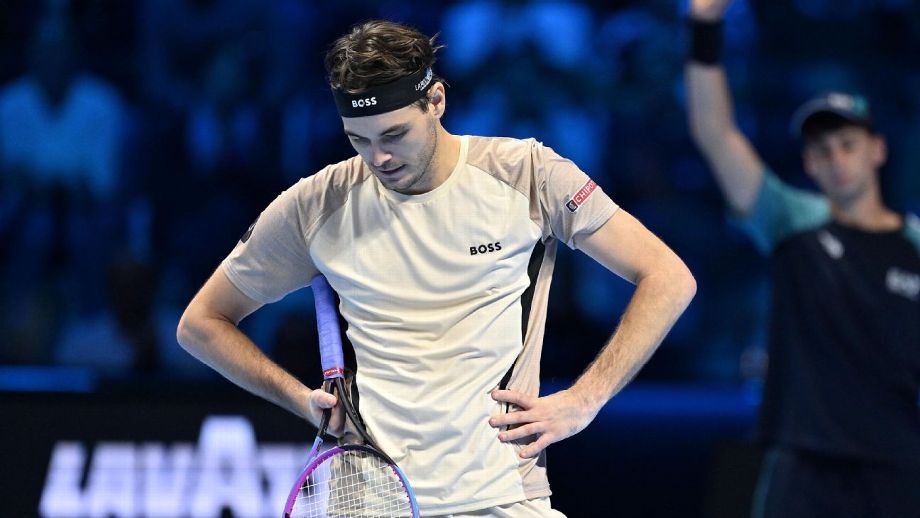Sports
Tennis Players Demand Change as Grueling Season Takes Toll

The professional tennis season is under scrutiny as players voice concerns about its demanding schedule. The 2024 season concluded on December 22, when Joao Fonseca triumphed over Learner Tien at the ATP Next Gen Finals in Saudi Arabia. Just five days later, the 2025 season kicked off with the United Cup in Australia, leaving players with little time to rest and recover.
Jordan Thompson, the 2024 US Open doubles champion, expressed frustration with the transition, stating, “I don’t know how the ’25 season starts in ’24. I mean, it’s a joke.” This sentiment highlights the increasing pressure players face due to the relentless nature of the tour, which has been a growing concern in recent years.
The short breaks between tournaments have raised alarms among athletes. While Fonseca and Tien enjoyed about four weeks without sanctioned events before the Next Gen Finals, the quick turnaround to the new season has drawn criticism. Notably, only a month separated the Billie Jean King Cup and the Davis Cup from the United Cup, which further complicates players’ ability to recover adequately.
Concerns about burnout have become a common theme in the sport. Alex de Minaur cited feeling “burned out” after an early exit at the French Open, while Iga Swiatek lamented the “super intense” schedule that prevented her from competing in a Billie Jean King Cup qualifier in the spring. The toll of the demanding calendar was evident in late September, when five out of twelve matches at the China Open ended prematurely due to mid-match retirements.
Several players, including Frances Tiafoe, Danielle Collins, and Daria Kasatkina, opted to end their seasons early, citing injuries and mental fatigue. Kasatkina’s candid admission on social media resonated with many: “The schedule is too much, mentally and emotionally I am at a breaking point and sadly, I am not alone.”
As the tennis community reflects on the 2025 season, discussions surrounding the length and intensity of the tour are expected to intensify. The pressing question remains: will any substantial changes be made soon?
The demands of the schedule have had varying impacts on players’ performances. Taylor Fritz enjoyed a breakout year in 2024, reaching the quarterfinals at both the Australian Open and Wimbledon, and competing in his first major final at the US Open. He concluded his season with two ATP titles, an Olympic bronze medal, and a career-high ranking of No. 4. Despite his success, Fritz noted the lack of an offseason, stating, “If you’re a top player, you actually get even less of an offseason.”
Fritz described his situation, explaining that after a successful season, he had only three weeks between the end of his 2024 campaign and the start of the new year. He pointed out that this brief time frame necessitated training, limiting his opportunity to truly relax. “I get one week off the whole year. It’s absurd,” he remarked.
The offseason is a critical period for players to make technical adjustments and coaching changes. However, many players, especially those from Australia, find themselves unable to fully disengage from the sport. Thompson expressed his desire to enjoy time at the beach upon returning home, but acknowledged the need to maintain physical fitness.
The challenges of taking breaks during the season are underscored by the requirements set by the ATP and WTA. Players must participate in a specific number of tournaments throughout the year. For ATP players, this includes all four Grand Slams, eight Masters 1000 events, and five 500-level tournaments. WTA players face similar mandates, which can lead to a relentless pursuit of ranking points, even at the expense of their health.
Both Aryna Sabalenka and Swiatek lost points at the end of the 2024 season due to not meeting the required number of tournaments. Swiatek, who was ranked No. 1 at the time, dropped to No. 2 as a result. The pressure to compete frequently has led to calls for a reevaluation of the current structure.
Swiatek, reflecting on her own experiences, noted, “I think we have to be smart about it, not really, unfortunately, care about the rules and just think what’s healthy for us.” Her concerns were echoed by others in the sport, including Gauff, who remarked on the difficulty of meeting all tournament requirements.
The recent Shanghai Masters highlighted the physical toll of the season, with players like Carlos Alcaraz and Jannik Sinner withdrawing or retiring due to physical issues. The final featured an unexpected matchup, with Valentin Vacherot, ranked No. 204, competing against his cousin Arthur Rinderknech, ranked No. 40, marking a departure from the high-stakes showdowns typically expected at such events.
Looking ahead, the ATP announced plans to add another Masters 1000-level tournament in Saudi Arabia by 2028, which will increase the total number of mandatory events. The scheduling of this new tournament remains uncertain, raising further questions about how it will fit into an already congested calendar.
In response to these challenges, the WTA stated that athlete welfare is a “top priority” and that it is in continuous communication with players. The organization aims to enhance the tour structure in 2024 to provide better compensation and clearer participation guidelines.
Despite these discussions, the road to reform appears complicated. Current ATP chairman Andrea Gaudenzi acknowledged the complexity of the calendar and the need to consider the diverse needs of players at various levels.
As the conversation continues, players like Novak Djokovic emphasize the necessity for unity among competitors to advocate for change. Djokovic has been a long-time critic of the current schedule and believes that players must engage more actively in the discussions surrounding their working conditions.
In conclusion, while there is a growing consensus among players that the tennis season requires adjustment, the path to meaningful change remains fraught with challenges. The balance between player health and the demands of the sport is delicate, and finding a solution that satisfies all parties will be crucial as the tennis community navigates the future.
-

 Science4 weeks ago
Science4 weeks agoInventor Achieves Breakthrough with 2 Billion FPS Laser Video
-

 Health4 weeks ago
Health4 weeks agoCommunity Unites for 7th Annual Into the Light Walk for Mental Health
-

 Top Stories4 weeks ago
Top Stories4 weeks agoCharlie Sheen’s New Romance: ‘Glowing’ with Younger Partner
-

 Entertainment4 weeks ago
Entertainment4 weeks agoDua Lipa Aces GCSE Spanish, Sparks Super Bowl Buzz with Fans
-

 Business4 weeks ago
Business4 weeks agoTyler Technologies Set to Reveal Q3 Earnings on October 22
-

 Entertainment4 weeks ago
Entertainment4 weeks agoMother Fights to Reunite with Children After Kidnapping in New Drama
-

 Health4 weeks ago
Health4 weeks agoCurium Group, PeptiDream, and PDRadiopharma Launch Key Cancer Trial
-

 World4 weeks ago
World4 weeks agoR&B Icon D’Angelo Dies at 51, Leaving Lasting Legacy
-

 Health4 weeks ago
Health4 weeks agoNorth Carolina’s Biotech Boom: Billions in New Investments
-

 Entertainment4 weeks ago
Entertainment4 weeks agoRed Sox’s Bregman to Become Free Agent; Tigers Commit to Skubal
-

 Science4 weeks ago
Science4 weeks agoNorth Carolina’s Biotech Boom: Billions Invested in Manufacturing
-

 Top Stories4 weeks ago
Top Stories4 weeks agoFormer Mozilla CMO Launches AI-Driven Cannabis Cocktail Brand Fast









